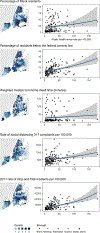Policing the pandemic: Estimating spatial and racialized inequities in New York City police enforcement of COVID-19 mandates
- PMID: 35273431
- PMCID: PMC8903094
- DOI: 10.1080/09581596.2021.1987387
Policing the pandemic: Estimating spatial and racialized inequities in New York City police enforcement of COVID-19 mandates
Abstract
The use of policing to enforce public health guidelines has historically produced harmful consequences, and early evidence from the police enforcement of COVID-19 mandates suggested Black New Yorkers were disproportionately represented in arrests. The over-policing of Black and low-income neighborhoods during a pandemic risks increased transmission, potentially exacerbating existing health inequities. To assess racialized and class-based inequities in the enforcement of COVID-19 mandates at the ZIP-code-level, we conducted a retrospective spatial analysis of demographic factors and public health policing in New York City from March 12-May 24, 2020. Policing outcomes (COVID-19 criminal court summonses and public health and nuisance arrests) were measured using publicly available police administrative data. After controlling for two measures of social distancing compliance, a standard deviation increase in percentage of Black residents was associated with a 73% increase (95% CI: 35%, 123%) in the COVID-19-specific summons rate and a 34% increase (95% CI: 17%, 53%) in the public health and nuisance arrest rate. Percentage of Black residents and historical stop-and-frisk rates had stronger associations with COVID-19 summons rates than multiple measures of social distancing compliance. Findings demonstrate pronounced spatial and racialized inequities in pandemic policing of public health that mimic historical policing practices deemed racially discriminatory. If the field of public health supports criminalization and punishment as public health strategies, it risks reinscribing racialized health inequities.
Keywords: COVID-19; coronavirus; law enforcement; police; race/ethnicity.
Conflict of interest statement
Declaration of Interest The authors have no conflicts of interest to declare.
Figures


References
-
- ASPE. 2019. 2018 Poverty Guidelines. https://aspe.hhs.gov/2018-poverty-guidelines.
-
- Beletsky Leo, LaSalle Lindsay, Newman Michelle, Paré Janine, Tam James, and Tochka Alyssa. 2015. Fatal Re-Entry: Legal and Programmatic Opportunities to Curb Opioid Overdose Among Individuals Newly Released from Incarceration. SSRN Scholarly Paper ID 2628297. Rochester, NY: Social Science Research Network. https://papers.ssrn.com/abstract=2628297.
-
- Berry Mary Frances. 2000. Police Practices and Civil Rights in New York City: A Report of the United States Commission on Civil Rights. DIANE Publishing.
-
- Bonell Chris, Michie Susan, Reicher Stephen, West Robert, Bear Laura, Yardley Lucy, Curtis Val, Amlôt Richard, and Rubin G James. 2020. “Harnessing Behavioural Science in Public Health Campaigns to Maintain ‘Social Distancing’ in Response to the COVID-19 Pandemic: Key Principles.” Journal of Epidemiology and Community Health 74 (8): 617–619. doi:10.1136/jech-2020-214290. - DOI - PMC - PubMed
Grants and funding
LinkOut - more resources
Full Text Sources
